
A handheld game console, or simply handheld console, is a small, portable self-contained video game console with a built-in screen, game controls and speakers. Handheld game consoles are smaller than home video game consoles and contain the console, screen, speakers, and controls in one unit, allowing players to carry them and play them at any time or place.

Palm OS was a mobile operating system initially developed by Palm, Inc., for personal digital assistants (PDAs) in 1996. Palm OS was designed for ease of use with a touchscreen-based graphical user interface. It was provided with a suite of basic applications for personal information management. Later versions of the OS were extended to support smartphones. The software appeared on the company's line of Palm devices while several other licensees have manufactured devices powered by Palm OS.

A Pocket PC is a class of personal digital assistant (PDA) that runs the Windows Mobile or Windows Embedded Compact operating system that has some of the abilities of modern desktop PCs. The name was introduced by Microsoft in 2000 as a rebranding of the Palm-size PC category. Some of these devices also had integrated phone and data capabilities, which were called Pocket PC Phone Edition. Windows "Smartphone" is another Windows CE based platform for non-touch flip phones or dumber phones.

Script Creation Utility for Maniac Mansion Virtual Machine (ScummVM) is a set of game engine recreations. Originally designed to play LucasArts adventure games that use the SCUMM system, it also supports a variety of non-SCUMM games by companies like Revolution Software and Adventure Soft. It was originally written by Ludvig Strigeus. ScummVM is free software that is released under the terms of the GNU General Public License.
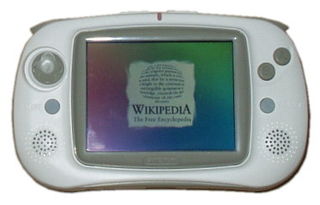
The GP32 is a handheld game console developed by the South Korean company Game Park. It was released on November 23, 2001, in South Korea and distributed in some parts of Europe.
The Zire Series was Palm, Inc's "consumer-grade" brand of Personal Digital Assistant.
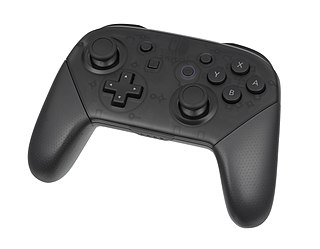
A gamepad is a type of video game controller held in two hands, where the fingers are used to provide input. They are typically the main input device for video game consoles.
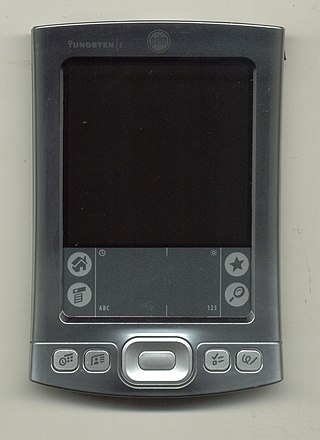
The Tungsten series was Palm, Inc.'s line of business-class Palm OS-based PDAs.
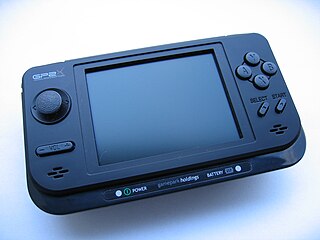
The GP2X is a Linux-based handheld video game console and portable media player developed by South Korean company GamePark Holdings. It was released on November 10, 2005, in South Korea only.
Yannis Brown is an Australian composer and sound designer for portable devices and consoles.
The Palm m500 series of handheld personal digital assistants consisted of three devices: the Palm m500, Palm m505, and Palm m515. The series was a follow-up to the popular Palm V series with a similar, though slightly shorter, footprint and form factor.

The Palm m100 series consists of four Palm OS based personal digital assistants titled m100, m105, m125, and m130. These models were intended to be "entry-level" PDAs, and therefore their cases were built from cheaper materials. Most notably, the covers of the LCD screens and the digitizers were plastic rather than glass, and the screens were smaller than the more expensive Palm devices on sale at the time.
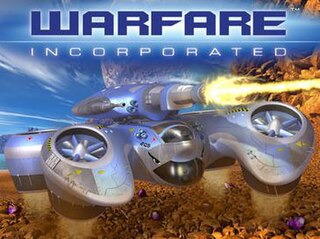
Warfare Incorporated is a real-time strategy game, released in 2003. It was developed by American studio Spiffcode and published by Handmark for Palm OS, Pocket PC, PDAs, Tapwave Zodiac and iOS. In 2014 the game became open-sourced and freeware under the name Hostile Takeover.

The Samsung SGH-E250 is a mobile phone that was introduced in October 2006 as an entry-level version of the Samsung D900/D900i. The E250 has very similar features to the D900/D900i, but the screen resolution is roughly half of that of the D900 and the camera is only 0.3MP compared to the D900/D900i's 3MP camera.

The Pandora is a handheld gaming computer originally released in 2010. It is designed to take advantage of existing free and open-source software and to be a target for homebrew development. It is developed and produced by OpenPandora, which is made up of former distributors and community members of the GP32 and GP2X handhelds. Until 2013, multiple batches of slightly updated Pandora variants were produced. In 2014 the development of a redesigned and upgraded successor, called DragonBox Pyra, was started.

The Dingoo is a handheld gaming console that supports music and video playback and open game development. The system features an on-board radio and recording program. It was sold to consumers in three colors: white, black, and pink. It was released in February 2009 and had sold over 1 million units.

The GP2X Caanoo, more commonly known as Caanoo, stylized CAANOO, is an open source, Linux-based handheld video game console and portable media player developed by the South Korean company GamePark Holdings. It was released on August 16, 2010 in South Korea and was also sold throughout Europe. It is the successor to the GP2X Wiz, and was showcased at the Electronic Entertainment Expo 2010. The device's launch price was about US$150, which did not reach any retail stores in North America.

The GCW Zero is a Linux-based open-source handheld video game console created by a start up, Game Consoles Worldwide. The GCW Zero was funded by a successful crowdfunding campaign on kickstarter.com on 29 January 2013 with US$238,499 collected, originally aiming for $130,000. The project was created by Justin Barwick. The device was eventually released that year.

The GPD Win 2 is a Windows-based palmtop computer that is the successor to the GPD Win. It is manufactured by Chinese company GamePad Digital, and crowdfunded just as its predecessor was. Announced in first-quarter 2017, the crowdfunding campaign officially kicked off on January 15, 2018, and quickly surpassed its goal. It was released in May 2018.

The Steam Deck is a handheld gaming computer developed by Valve and released on February 25, 2022. The device uses Valve's Linux distribution SteamOS, which incorporates the namesake Steam storefront. SteamOS uses Valve's Proton compatibility layer, allowing users to run Windows applications and games. In addition to handheld use, the Steam Deck can be connected to a TV or monitor through a docking station and be used like a desktop computer or home video game console. In desktop mode, users can install third-party applications for Linux.



















